There are longer rivers in the UK but with an average water volume of 180 cubic metres per second, no other river comes close to the sheer size of the Tay. It’s massive and when you consider early season water temperatures are often in the low 30s deg F, then you begin to understand why there is a longstanding tradition of spinning in the early months of the season. Catch records going back to the early 1900s show that all fish in the early season were caught using spinning lures. These might have been natural ones like the sprat, or artificial ones like the Devon Minnow. It was a similar story on virtually every medium and large river in the UK.
Quite simply, spinning is the most efficient way of fishing the river at this time of year. There’s truth in the adage: “Fly to Try, Spin to Win”.
Springers are superb taking fish. Colder water means more dissolved oxygen and these conditions lead to active fish that take a lure well. That’s not to say the fishing is easy, and you need to make sure you arrive on the riverbank with the correct tools for the job. Most anglers have heard of the Devon Minnow, but there are other lures your gillie would hope you’d have in your box when you start your day. These lures are the bread and butter of a day’s spring fishing.
Devon Minnow
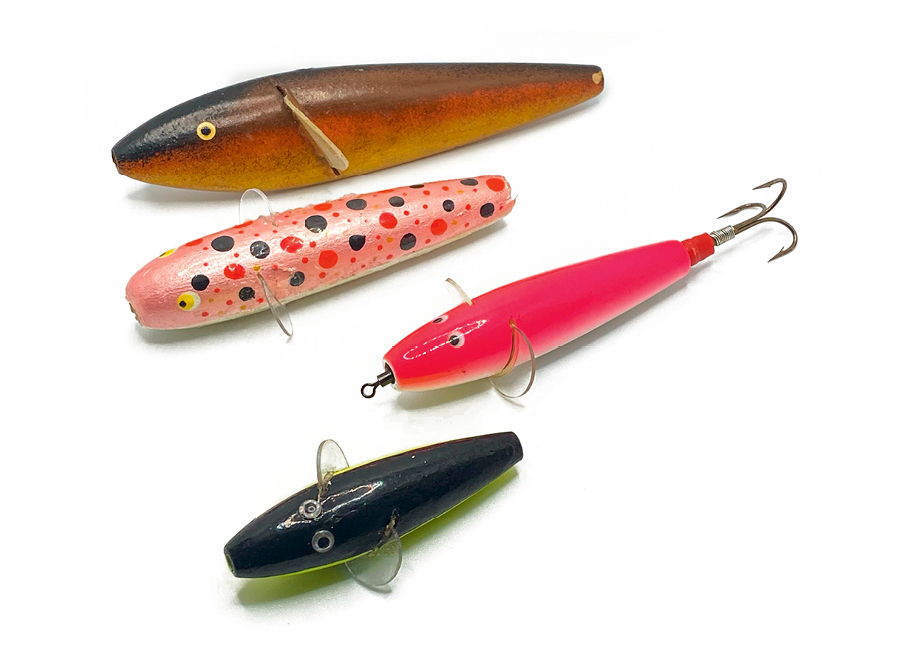 Floating Devons in proven spring colours.
Floating Devons in proven spring colours.
In the past, weighted minnows were common, but latterly the wooden “floater” has increased in popularity. The minnow is attached via a leader, swivels and trace to the main line and held near the river bottom by a lead weight on a dropper (Diagram 1). It can be fished very slowly, with the lead occasionally tapping the riverbed as the Devon hovers and flutters a few inches higher.
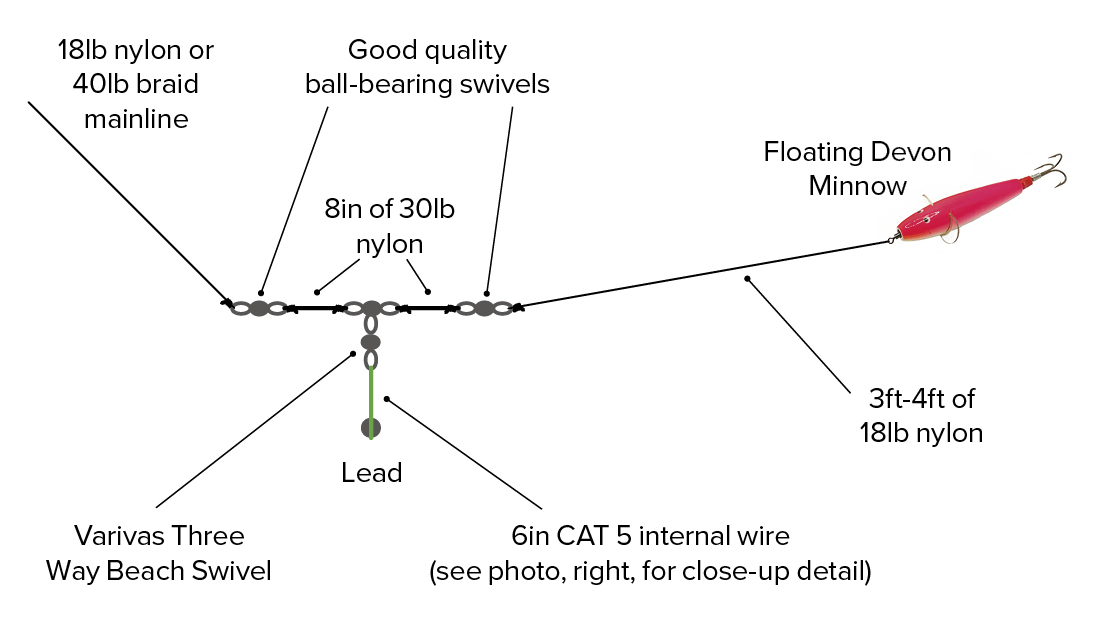 Diagram 1: Floating Minnow Rig.
Diagram 1: Floating Minnow Rig.
I use a long rod, 10ft-12ft, for better line control, with a casting weight of 20g-60g. My reel holds a minimum of 200m of 18lb nylon or 40lb braid. Increasingly popular, braid offers the comfort blanket of extra strength with the casting benefits of its small diameter.
My leader set-up ensures I fish the “floating” minnow tangle-free right where the fish are lying. I don’t skimp on the quality of the ball-bearing swivels at either end of the trace. I use the Varivas Three Way Beach Swivel in the middle, which allows the weight link to rotate on the axis in the middle of your trace. The more traditional three-way swivel does not work as well. This tried-and-tested approach cuts down on tangles significantly.
I then have a 3ft-4ft leader to the lure and a pocketful of leads, 15g-60g. These are attached to the three-way swivel with 6in of internal wire from a CAT 5 UTP Network Cable (ethernet), which allows the lead to be changed quickly.
The benefit of this set-up is that if your lead gets stuck, then a bit of pulling will free the rest of the outfit, minimising losses. I avoid Bouncing Betty weights in spring as I find their additional buoyancy stops my bait from fishing as deep as I would like.
I cast slightly upstream, keeping the bale arm open and rod held high, to make sure the rig gets down quickly, then I close the bale arm and start fishing. I want to feel the lead tapping the bottom and then I’ll know my lure is in the right place. I change the weight of my lead as often as I need to ensure the minnow is fishing at the right depth. I do everything I can to control my line with a high rod tip, which prevents my lure being dragged out of position. I will fish my lure into the side — the bigger the water, the closer the fish are to the side. A characteristic of many anglers is to cast to the horizon but in high water this wastes much valuable fishing time. Spring days are short, so maximise your effective fishing time.
Having fished my lure to the side, I’ll wind in, take two paces downstream and repeat.
Colours worth trying in spring include yellow belly (green/yellow), brown-and-gold, black-and-yellow, and pink-and-white — if you can find them.
Vision 110
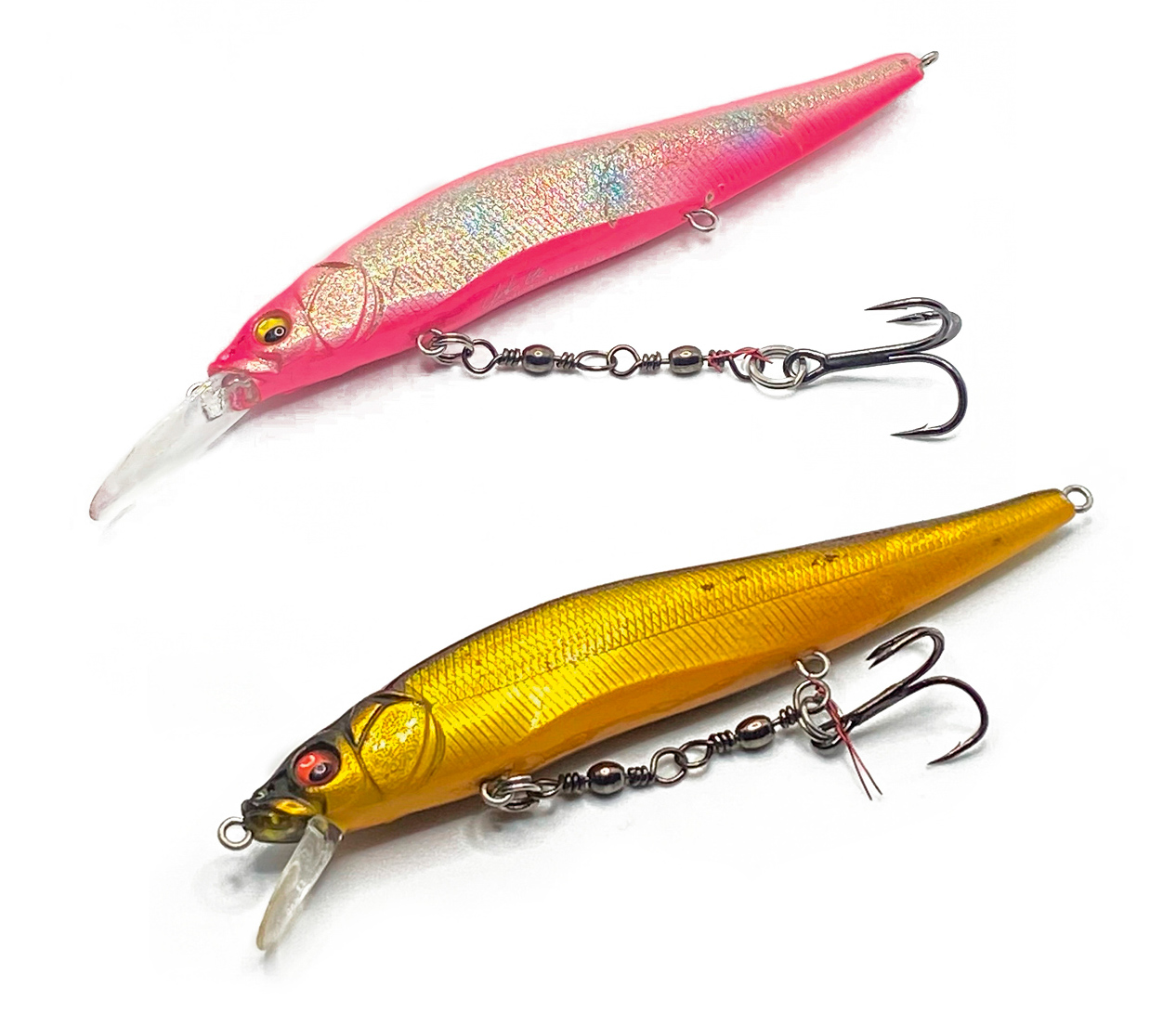 Top: Vision 110 with a “Tay rig”. Bottom: Using fuse wire, tie the rig to the middle hook ring.
Top: Vision 110 with a “Tay rig”. Bottom: Using fuse wire, tie the rig to the middle hook ring.
What an impact this lure has made to the world of salmon spinning. It’s had a place in most lure boxes for the last 10 to 15 years, and if you don’t have one, you ought to! The 110 refers to its length (110mm) and it typically fishes at a depth of about 4ft. It’s worth buying the 110 Plus as well. It has a bigger vane, which takes the lure down to 6ft or so, often useful in the higher, cold waters of spring.
The 110 is a light lure, about 14g, and relies on its vane, not its weight, to get it down. Its lightness means that a thin-diameter braid is needed to cast it effectively.
I cast at 90 degrees to the bank, engage the bale arm straight away and keep as much braid out of the water as possible to avoid the current dragging the lure out of position. Half a dozen very quick turns of the handle will get the lure down to the fish and then I retrieve very slowly (counting one and two and three with each turn of the reel handle) fishing the lure right to the bank. Slowly! The fish will not move far or fast to take a lure in cold water. I take two paces downstream and repeat the process.
Visions 110s are fitted with three hooks and with the welfare of the fish and, surprisingly to some, the efficiency of the hooking in mind, you should remove the three split rings and trebles and create a “Tay rig” using a split ring, double swivel, another split ring and a size 4 treble. This is tied with fine fuse wire (5 amp) or fly-tying wire to the middle hook ring. Just a few twists are needed to hold it in place, but it will easily break free when a fish takes. This method eliminates any chance that the extra trebles might hook the fish on the outside of its mouth and eliminates the leverage that comes from using three hooks. Sometimes less is more!
Stalwart colours to try include Kinkuro (black/gold/orange), RB Shad (silver/red belly) and
Stardust Shad (silver/yellow belly). It’s worth trying pink ones as well. Very effective similar lures to the 110 are available at a fraction of the price of the original, and often available in more “salmon suitable” colours.
| Tackle checklist |
■ 10ft-12ft spinning rod (20g-60g casting weight)
■ Spinning reel capable of holding 200m of 18lb nylon or 40lb braid mainline
■ 18lb nylon leader
■ Ball-bearing swivels (Spintec)
■ Varivas Beach three-way swivel
■ CAT 5 UTP Network Cable, stripped off the sheath to expose internal wires, used to attach leads.
■ Devon Minnows
■ Toby Salmos
■ Vision 110s
■ Kynoch’s Killers
■ Leads (20g-60g) |
Toby Salmo
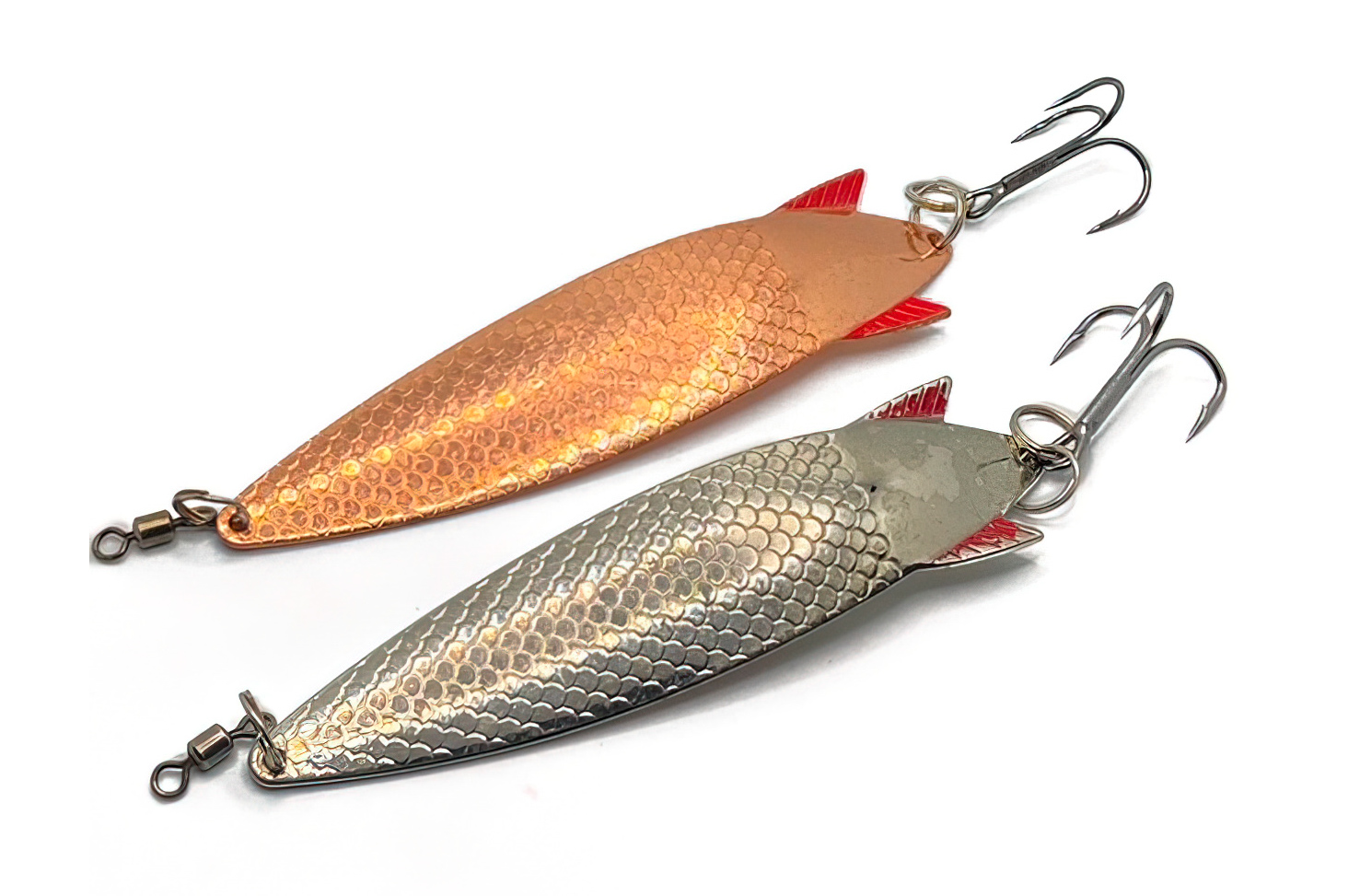 Calum recommends replacing the split rings and hooks of new lures.
Calum recommends replacing the split rings and hooks of new lures.
The Salmo is 30g and a good casting lure. It will account for more fish on the Tay than any other. First made in 1969, its popularity grew quickly as anglers favoured its convenience over the natural sprat. Key colours are silver, copper and silver/copper. In my experience, the fitted split rings and hooks are as soft as toffee and should be immediately replaced — not after you lose a fish as a result of an opened ring or bent hook. I buy replacement components from a company called WLure, which are competitively priced and tried and tested by myself and other Tay gillies. The Salmo is a superb lure for sweeping across the broad Tay pools. I cast just slightly upstream to get it a bit deeper with a high rod tip to avoid line drag, and I can swing it through the pool with little or no retrieving.
Kynoch’s Killer
 Fish the classic pink-and-white scheme, and if that doesn’t work, try white-and-pink… This is such an effective colour combination in the cold waters of spring — something diehard fly-anglers who can’t be swayed by this article would do well to explore.
Fish the classic pink-and-white scheme, and if that doesn’t work, try white-and-pink… This is such an effective colour combination in the cold waters of spring — something diehard fly-anglers who can’t be swayed by this article would do well to explore.
Likened to an ice cream cone, this highly effective lure is used almost exclusively on the Tay. More associated with boat fishing, it can work well from the bank, especially if fish are lying close to the side. You can hold the lure over the fish and almost provoke a take as it swims in front of their noses.
There is a pool at Meikleour called the Boxwood Bush where there’s deep water at your feet. Long casts aren’t necessary and by holding a rod out at 90 degrees to the bank I can fish a lure very slowly in the “taking zone”, waiting for a fish to strike (Diagram 2). A small lead 3ft-4ft above the lure gives me extra casting distance and helps me to fish the lure a bit deeper. It is no coincidence that in spring every boat on the Tay will be harling this lure — it is highly effective.
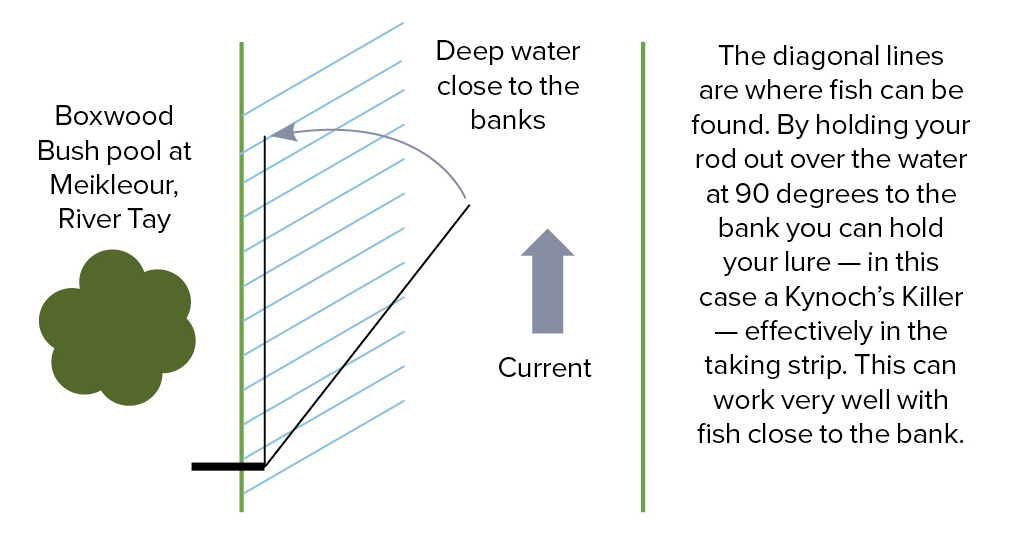 Diagram 2: Fish the near bank.
Diagram 2: Fish the near bank.
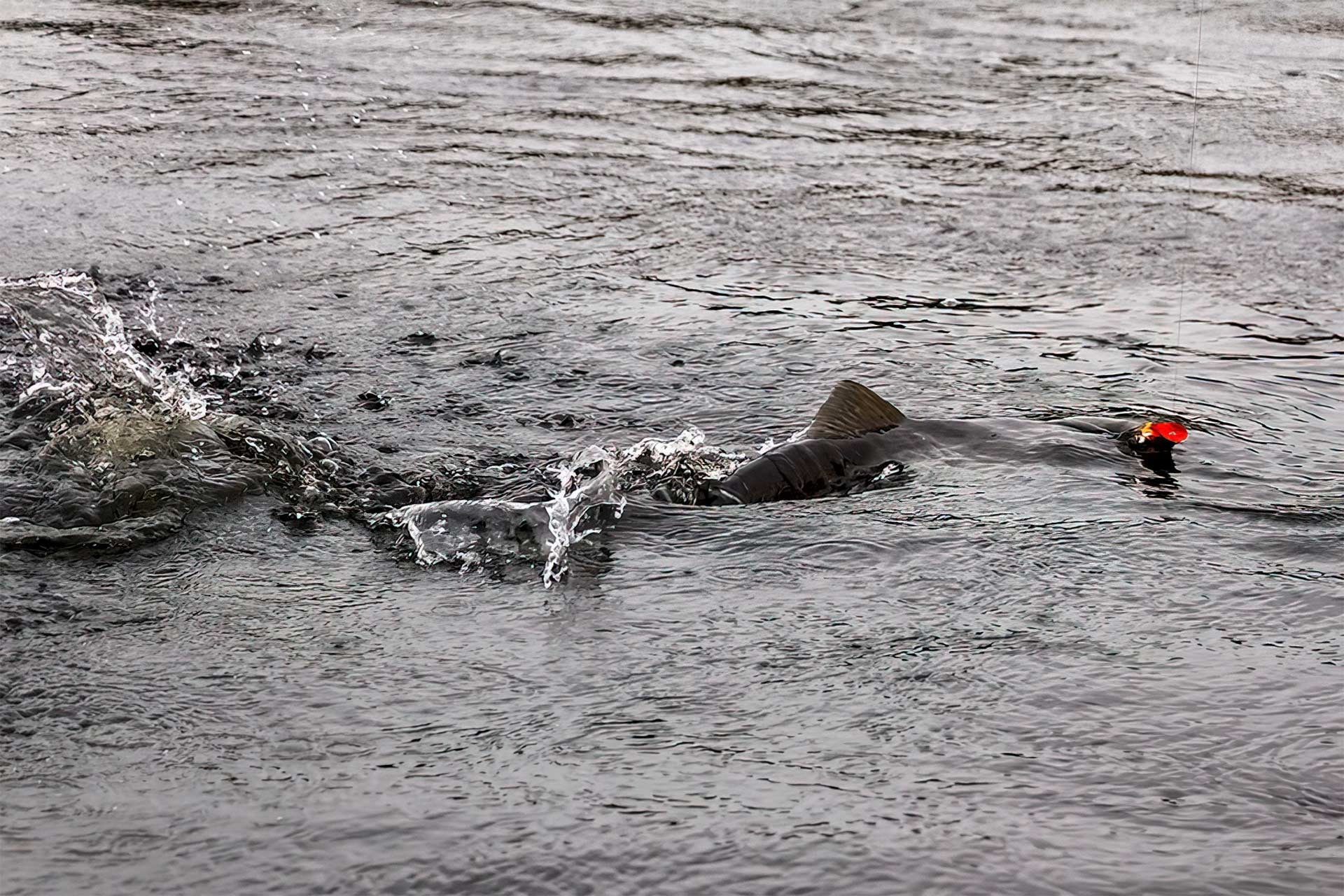 One on a Kynoch.
One on a Kynoch.
Research, research, research
There won’t be many fish in the water at this time of year, so you’ll need to search for them. Speak to the gillie and heed their advice. Fish the water methodically. If your water doesn’t have a gillie, look for quiet areas out of the main flow and natural or man-made obstructions and features — and fish below them. These temperature barriers will slow the fish, giving you a greater opportunity of finding them. You will catch springers at any time of day, so keep your head up and fish every cast like it’s going to be the one. Many a football match is won with the last kick of the ball.
Make sure you are fishing the right parts of the whole river. There is little point in targeting a beat if it doesn’t hold fish in spring. Don’t look at the annual return — look at monthly totals. Do your research. Ask questions. Phone the gillie. I’m not convinced when I hear “There’s nobody fishing, so no fish are being caught.” If there are fish to be caught, there will be people fishing.
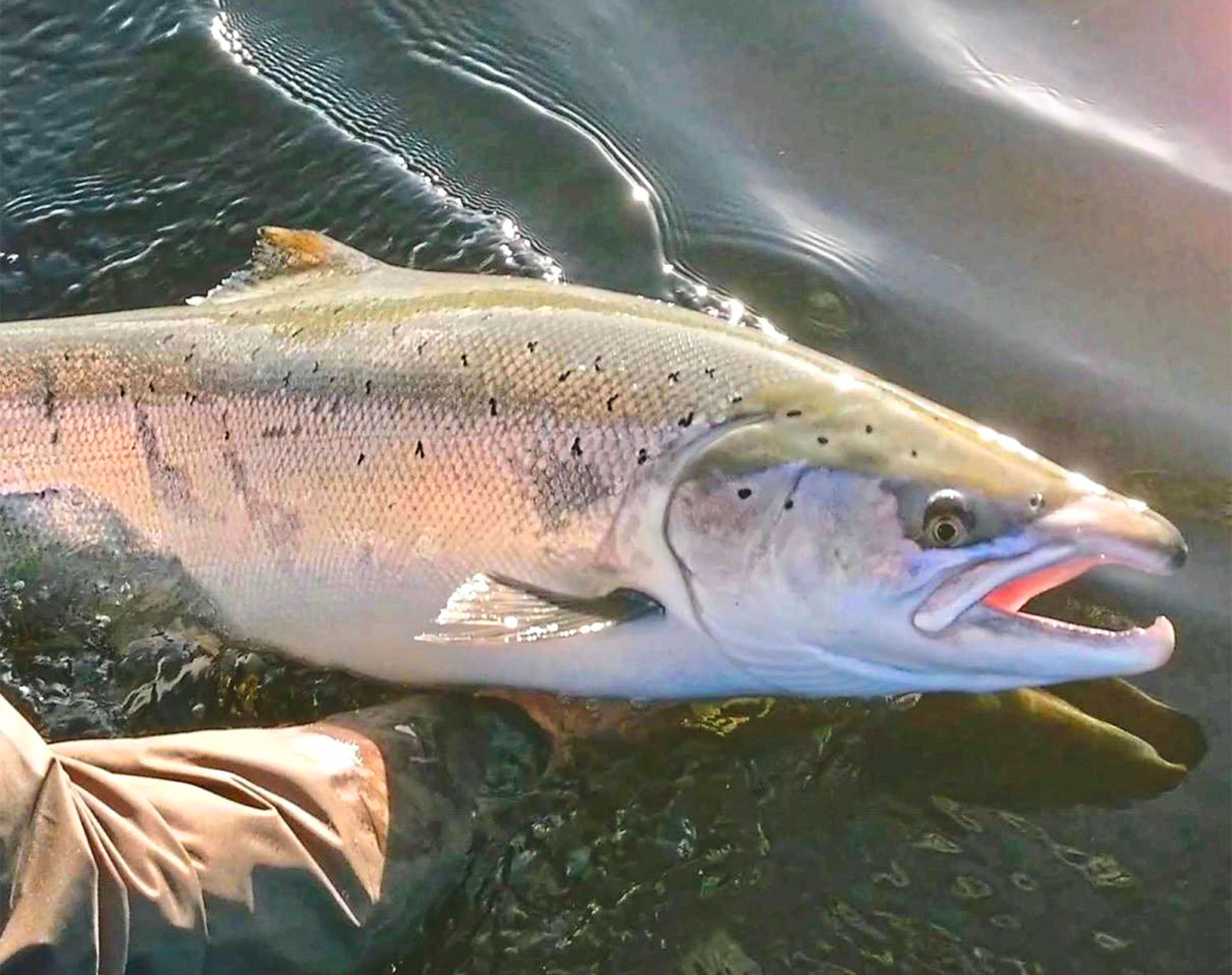
| Fish Care |
|
Respect your prize. Spring fish will sometimes be in the river for 12 months before spawning and are the most vulnerable of salmon. We must do all we can to protect their welfare. Carry a net — there is no place nowadays for dragging fish up a bank. Keep the fish in the water. Avoid touching it. Spring fish have little mucus and shed scales easily, leaving them vulnerable to infection. Ask yourself if you really need a photo of you holding a fish, when you can hold the net and still see the fish. Is it worth compromising the welfare of the fish?
Someone far wiser than me once said “Keep a fish out of water for as long as you would like to be held underwater”. Words that should always be in our thoughts when it comes to returning our fish.
|